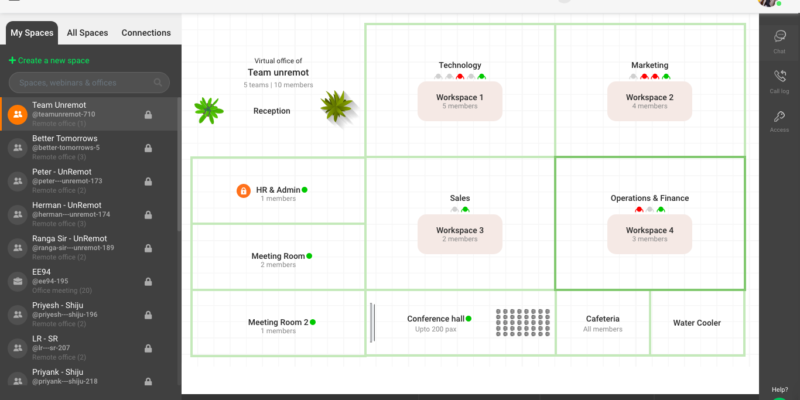Are you struggling with declining employee motivation? Want to know how to motivate employees with the changing times of 2021? Here’s a list of tips, tools to be used, and best practices. Read on!
How to motivate employees?
One of the responsibilities of a manager is inspiring and motivating employees. Motivators in management look for new ways on how to motivate employees and increase customer engagement. A motivated workforce is more likely to work independently and let owners or management focus on long-term goals.
Corporate motivation techniques improve employee engagement and productivity. Managers can find ways on how to motivate employees to increase their efforts by leading from the front. In this blog, we attempt to explain how to motivate your employee? Or tips on how to motivate employees, what motivates workers? What motivates workers? We provide some ideas to motivate staff.
Also Read: Deep work summary | An ultimate read for best results
What is employee motivation?
Employee motivation is the level of enthusiasm, commitment, diligence, and resourcefulness that employees bring to work. Employee motivation is about how connected your staff feels to the company’s goals and how empowered they feel. It is vital to balance employee motivation as over- rewards or praise can backfire. We classify motivation into,
- Intrinsic motivation is when individuals are self-motivated. These employees perform well because of their belief system. Research shows motivation techniques with praise can help increase intrinsic motivation.
- Extrinsic motivation is when individuals when motivated by external factors such as recognition and rewards. Extrinsic rewards can be the motivation to learn new skills.
Also Read: Depth of knowledge | A priceless list of tips to succeed
Benefits of motivating employees
There are several benefits of motivating employees in the workplace,
- Handle uncertainty and change better – Motivated workers are more engaged and confident. The workers can handle uncertainty and organizational change better.
- Better problem-solver – Managers expect their staff to solve problems. Staffs who are motivated to work are better problem solvers.
- More Innovative and creative – Motivating staff has the added benefit of being more engaged, they are more likely to think about innovative ideas to optimize workflow.
- Proactive – If you motivate workers, they will be more proactive to look for new solutions to achieve goals.
- Higher productivity – Motivations for work result in higher productivity. Motivated and engaged employees are more productive.
- They understand and work toward the company goals- Motivated workers understand how their work contributes to the company’s success. They are keen to understand and company’s mission, vision, and objectives.
- Consumer-centric – Both B2B and B2C companies need to interact with their clients. Employees who are motivated at work care more about consumer satisfaction.
- Retention levels are higher – Fluctuation of the workforce is more when employees are not motivated. You have higher employee turnover.
- Work toward their own goals – Motivated workers work hard towards meeting targets to work towards their own goals.
- Better team players – If you realize how to motivate employees at work, they are more likely to become team players.
Also Read: Remote work habits | A comprehensive guide
3 indicators of lack of work motivation in your team
You may have to look for motivation techniques for employees if your employees show the following signs,
- They are reactive, not proactive – When employees are unmotivated are more reactive to situations. They are unlikely to take preventive steps to stop potential problems from occurring.
- They are not participating – Motivated employees speak up when they need clarification or have an idea. They are willing to participate and learn. When team motivation is low, there are communication problems. Conversation can be one way. The employee follows orders without interacting.
- Poor body language – Body language is a good indicator of your staff’s state of mind. Arms crossed, eye-rolling, shrugging shoulders, and loud sighs could be signs of poor motivation.
Also Read: How to prioritize task | Everything you must know
Human psychology of what motivates employees
Before we discuss different motivation strategies, you need to understand what motivates your employees,
- Purpose of work – Employees need to find meaning and purpose in their professional work or do meaningful work.
- Positive company culture – One of the motivations at work is the company culture. Components of company culture are- Well-being, compassion, and diversity, inclusion, and equality.
- Receive recognition for their work – Motivational staff gets acknowledged for their contributions and achievements at work.
- Learning opportunities – Upskilling your employee’s present skills show you want to partner in their development.
- Clear career progression – Opportunities for promotion and career growth motivate staff.
Also Read: Office management | A complete guide
Challenges in enabling motivations at work
We will elaborate on how do you motivate your employees in a later session, we will discuss the challenges in motivating employees,
- Poor leadership structure – This problem occurs when no one is in charge or there is a lack of hierarchy. Employees lose their motivation to work because of the lack of clarity, poor job description, and unclear objectives. Poor leadership structure can lead to a lack of confidence in the company.
- Lack of challenging work – Employees get bored in this scenario. Employees who cannot find motivation at the workplace may perform poorly. Possible reasons for poor performance can be:- wrong hires, not utilizing the skill set of the employee, or may the lack of professional job opportunities.
- Workplace conflict – Workplace conflicts occur when there are disagreements with the management or between employees. Conflicts can reduce motivation for employees, lower productivity, and lead to a toxic work environment.
Also Read: Cybersecutity during work from home | Critical items that you must know!
The target audience of team motivation initiatives
One of the vital managerial functions is motivating your team. Here are some motivational strategies for employees,
- Give your team questions and not answer – the best team leaders ask questions instead of providing solutions. Outline the problem and the final goal of the project. If you are wondering how to motivate your team is by encouraging them to seek solutions. Encourage them by asking thought-provoking questions.
- Link rewards to team success and not individual accomplishments – You need to remember teams and solo employees are very different. While evaluating an individual, you need to account for their performances and skills and how they work and interact with team members. Evaluate the success of the team as a whole, and not individual performances to get the best results from the team. Recognizing contributions and showing appreciation is a vital tool for motivation.
- Set aside space for experimentation – Encourage your team to experiment within boundaries. If you want the best from your team, you need to encourage employees to be creative.
Also Read: How to measure productivity | A how-to guide for everyone
Top 15 ways on how to motivate employees
Employees are a vital resource of businesses. Companies that motivate their employees nu maintain an enthusiastic work environment. A well-thought-out motivation strategy is important to motivate employees. You need to measure the effectiveness of the strategy.
1. Motivate at work by choosing the right leader
One of the ways to motivate staff is to choose a good leader. Good leaders can motivate and engage with their team. Some of the top issues that can prevent effective leadership are not recognizing achievements, unclear directions, not taking out time to interact with subordinates, and unwillingness to listen to ideas.
2. Motivate for work by coaching managers
The best way on how to motivate employees is to ensure managers receive management coaching required to keep employee motivation high. The workforce has become dynamic. Remote workers have become an integral part of offices. Employee engagement and motivation techniques have to be modified to account for the changes. Coaching helps to motivate managers by giving them additional skills.
3. Motivating at work by giving precise and realistic engagement goals
It is critical managers assign clear and measurable goals and objectives to their team. If the task is big, consider breaking the tasks up into more manageable chunks. Employees who have clear and measurable goals are more motivated. Make sure the goals are SMART (specific, measurable, achievable, realistic, and time-bound).
If you are wondering what practical steps can a manager take on how to motivate employees to increase their effort? Let your employees know how their work contributes to the firm’s objectives.
4. How to motivate employees by holding someone accountable
The responsibility of a leader does not end after assigning goals. If the employee fails to achieve the targets, the manager is held accountable. It could mean engagement levels with the employee were not insufficient. The manager needs to do root cause analysis, modify and improve their engagement tactics.
5. Envision and share positive out can be great employee motivational ideas
It is easier to achieve success when you envision it. These can be powerful employee motivational techniques used by successful professionals. Help your team understand the objective and what it means to be successful. When your team makes real progress toward the goal, share it to motivate people in your team.
6. Improved communications help employees feel motivated at work
Good internal communication is a powerful employee motivator in the workplace. Internal communication helps the management learn about ideas, attitudes, or concerns. Interactions help managers learn new ways to optimize operations.
7. Employees who receive structured feedback are motivated for work
Management needs to give employees feedback, whether it is positive or negative. Continuous feedback allows employees to understand specific areas of improvement.
8. Rewarding employees is an excellent motivation to workers
Employees like being appreciated and valued. It is important to reward good work. Recognition and rewards provide motivate for work. The rewards need to be with something the employees will value.
9. Connecting with your employees is a technique used for motivations for work
Good leaders connect with their employees on a professional and personal level. This will help to engage with the employees on a personal level.
10. Build a positive environment works as motivation to work
A healthy work environment is somewhere where people feel free to voice their opinions and ideas and feel valued. The employees trust their team leaders and have a good relationship with their colleagues. Ensuring your organization is not toxic, but a safe nurturing environment. The office environment is a key element of motivation management.
11. Encourage innovation to motivate to work
Having an inclusive team environment, providing freedom and flexibility at the workplace, and encourage sharing knowledge sharing are just some of the steps to encourage innovation and creativity. Besides, motivate management innovation encourages teamwork and team bonding.
12. Empowerment is one of the best motivation techniques
Give your employee more freedom to make decisions themselves. Empowerment helps your staff believe in themselves and realize their potential. Showing confidence in your team is one of the best employee motivation techniques.
13. Programs that help to be motivated to work
Having a learning and development program for the staff can be an excellent motivation to workers. Advantages of learning programs like:- increased efficiency, reduced need for monitoring, and labor-management situation.
14. Motivation strategies of addressing quality of life
One of the motivational techniques for employees is ensuring they have a work-life balance. Hardworking driven employees often have burnout. You need to take care of your staff.
15. Motivation strategy to understand what the team needs
Remember all employees are not the same. You need to understand what motivates your employees – it may be monetary rewards, while some prefer public recognition. Identify and deliver a customized strategy for your team.
Also Read: Time blocking | An ultimate read for best results
Recent global trends in motivation in management
Businesses are looking for new ways on how to motivating staff. Some of the latest methods of motivation techniques are,
- Education and Training – Companies that provide training opportunities for their employees. This has the dual benefit of motivated staff and a more skilled workforce. When companies provide additional training it gives the message, the company is keen to be a partner in the employee’s growth and development.
- Work-life benefit – Organizations helping employees to achieve a balance between their personal and professional obligations. Greater flexibility as motivation management technique with flexible time with the option of working from home
- Feedback – Feedback is one of the biggest trends. Feedback is not only from teammates or managers but also from customers. The motivation strategy helps to show the employee a perspective about how their actions impact the customer.
Also Read: Inbox zero | A priceless list of tips to succeed
5 ways on how to motivate employees when they are fully remote
Strategies on how to motivate employees when they are fully remote are,
- Keep mission at the top of the mind – To motivate your team they must be aware of the goals of the project and how their work matters. Mission-oriented communication is important needs to be constant.
- Always provide feedback – Regular feedback is critical to motivating teams. It helps to provide expectations and objectives. Feedback demonstrates you care about your team.
- Think about remote company culture – In a remote office, it is important for staff to feel connected with the company. Recognizing people who go above and beyond is important.
- Empowerment – Empowering your team to make decisions shows trust. Regular meetings to look for ways to improve remote processes. Empowering is an excellent work motivation technique.
- Breaks – Remote work often means poor work-life balance. Enforcing short breaks keeps the team energized.
Also Read: Remote working tools | A comprehensive guide
Software motivation tool
Several software motivation tools help in employee motivation in the workplace:-
- Virtual Watercooler – Unremot watercooler is a virtual room where employees can interact with each other it helps to reduce the sense of isolation in a virtual setting. It is an ideal setting where managers can inspire employees or motivate staff.
- TINYpulse – Tinypulse allows management to understand workplace problems. One of the features of the tool is that it offers real-time feedback for recognition is a great staff motivational tool.
- Kudos – Kudos is an employee recognition system and corporate social network. It is a motivation tool that encourages and engages employees to create connections with the corporate culture. You can use it for peer and management feedback and badges and certificates.
Also Read: Home office set up | Everything you must know
How to motivate employees at work during Covid?
Motivating your employees during Covid19 requires you to stay calm and positive. Management needs to be transparent about changes in operations and strategy. You need to create flexible workplace policies. Let your staff know you care about their safety during the pandemic. People are scared and stressed during the pandemic. Motivational managers check-in to ask how their team is doing and if they can help.
What did managers and owners want for their workers?
Managers and owners want their workers to be more productive. The workers should be motivated for work. The employee should proactively work towards team and company objectives.
Also Read: Distributed teams | A complete guide
How do you motivate employees?
Some of the ways to motivate your employees are,
- Praise employees when they have done a good job.
- Do not micromanage or be a control freak. Let employees work with more freedom.
- Treat your staff with respect.
- Allow staff to express their opinions
- Ensure healthy work-life balance
- Avoid double standards
- Pay your staff well
What practical steps can a manager take to motivate employees to increase their effort?
If you wondering how to motivate employees, here are some employee motivational ideas you can use,
- Encourage open communications
- Create an agile work environment
- Be someone you want to work for
- Offer rewards for meeting targets or goals.
- Encourage workplace camaraderie
- Invest in your team’s happiness
Why is it a good idea to have one person in charge of office operations?
It is a good idea to have an operation manager, who oversees production within the company. One of their core responsibilities is to motivate employees to ensure high productivity. A dedicated person for office operation can ensure the stability and growth of your business.
Also Read: Virtual field trips | Critical items that you must know!
How to motivate employees as a manager?
5 ways on how to motivate employees used by managers are,
- Recognition when a job is well done – managers motivate their staff by recognizing when something is well done. It does not have to be lavish or excessive but public recognition.
- Mentoring – Motivational managers coach their staff. During the one-on-one interaction, the manager can talk about challenges and opportunities in the organization. They can offer constructive criticism to improve and provide praise when deserved.
- Leadership Opportunities – employee motivation strategies can be giving promotion to deserving candidates. It helps to motivate the employee and helps in retention.
- Break from norms – Employees need a break from the daily grind. Organizing employee engagement on-site and off-site events can help provide a break.
- Importance and optimism – You can encourage employees by giving them a sense of optimism and importance about their work.









